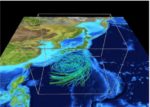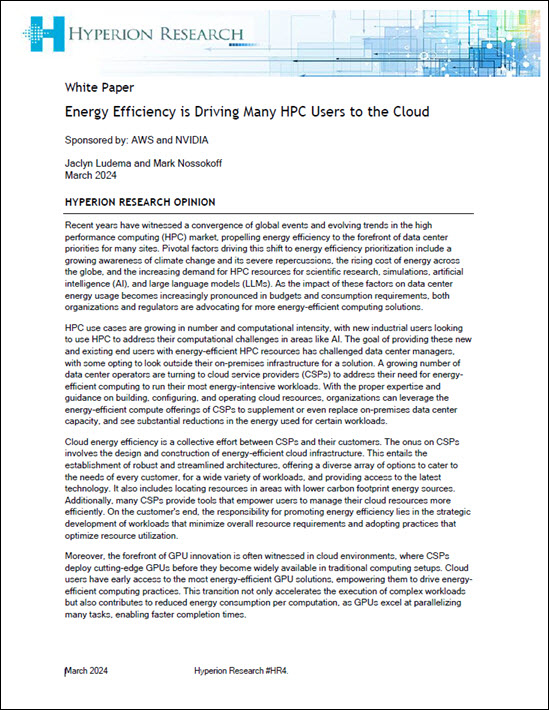In this video from ISC 2019, Dr. Rudolf Fischer from NEC describes how the company’s recent win at DWD demonstrates the power and efficiency of the SX-Aurora supercomputer. “The new HPC system will enable the development of seamless prediction of severe weather events, including thunderstorms or heavy rain. The system combines forecasting based on observations with very demanding numerical weather prediction models in order for a more precise prediction of the development and the tracks of such small-scale weather events up to twelve hours into the future.”
MeteoSwiss to Improve Weather Forecasting with Cray CS-Storm Supercomputer
At ISC 2019, Cray announced that CSCS in Switzerland is adding a third Cray CS-Storm supercomputer to support the development of cutting-edge weather service products at MeteoSwiss. “MeteoSwiss found success with its existing Cray supercomputers and selected this new CS-Storm to provide the additional computational power required to process increasing volumes of weather observations and produce higher fidelity forecasts. The CS-Storm system was also selected for its ability to run numerical weather forecasts within a reduced energy footprint (as compared to competing solutions), and for the reliability the platform provides MeteoSwiss when running critical workloads.”
NEC receives 50 Million Euro order from Germany’s DWD
Today NEC announced that it received an order for an NEC SX-Aurora TSUBASA supercomputer with a value of 50 Million Euro from the Deutscher Wetterdienst (DWD), the German weather forecasting service. “The new HPC system will enable the development of seamless prediction of severe weather events, including thunderstorms or heavy rain. The system combines forecasting based on observations with very demanding numerical weather prediction models in order for a more precise prediction of the development and the tracks of such small-scale weather events up to twelve hours into the future.”
Cray Powers Weather Forecasting at ZAMG in Austria
Today Cray announced that the Central Institution for Meteorology and Geodynamics in Austria (ZAMG) is using a Cray supercomputer to support a multi-year weather nowcasting project with the University of Vienna to benefit society and industry. “Using deep learning methods, ZAMG is leveraging its Cray CS-Storm supercomputer to optimize the orientation of wind-powered generators for maximum efficiency and to train neural networks with current and historical weather data.”
Video: Advancing U.S. Weather Prediction Capabilities with Exascale HPC
Mark Govett from NOAA gave this talk at the GPU Technology Conference. “We’ll discuss the revolution in computing, modeling, data handling and software development that’s needed to advance U.S. weather-prediction capabilities in the exascale computing era. Creating prediction models to cloud-resolving 1 KM-resolution scales will require an estimated 1,000-10,000 times more computing power, but existing models can’t exploit exascale systems with millions of processors. We’ll examine how weather-prediction models must be rewritten to incorporate new scientific algorithms, improved software design, and use new technologies such as deep learning to speed model execution, data processing, and information processing.”
How Deep Learning Could Predict Weather Events
Seongchan Kim from KISTI gave this talk at GTC 2019. “How do meteorologists predict weather or weather events such as hurricanes, typhoons, and heavy rain? Predicting weather events were done based on supercomputer (HPC) simulations using numerical models such as WRF, UM, and MPAS. But recently, many deep learning-based researches have been showing various kinds of outstanding results. We’ll introduce several case studies related to meteorological researches.”
Podcast: Weather Forecasting Goes Crowdsourcing, Q means Quantum
In this episode of Radio Free HPC, Dan, Henry, and Shahin start with a spirited discussion about IBM’s recent announcement of a “crowd sourced weather prediction application.” Henry was dubious as to whether Big Blue could get access to the data they need in order to truly put out a valuable product. Dan had questions about the value of the crowd sourced data and how it could be scrubbed in order to be useful. Shahin was pretty favorable towards IBM’s plans and believes that they will solve the problems that Henry and Dan raised.
ESCAPE-2 Project to develop algorithms for weather and climate prediction at exascale
Today ECMWF launched the ESCAPE-2 project on energy-efficient scalable algorithms for weather and climate prediction at exascale. “It brings together 12 partners, including national meteorological and hydrological services, HPC centers, hardware vendors and universities. The ESCAPE project aims to prepare NWP and climate models for new computing architectures towards exascale computing, with a focus on energy efficiency.”
GPUs Power Performance Breakthrough on TempoQuest Weather Prediction Software
Today TempoQuest announced that it has achieved a breakthrough 700% acceleration of the weather community’s Weather Research Forecast (WRF) model used extensively for real-time forecasting and weather research throughout the world. “The acceleration of regional weather processing times has presented a challenge to forecasters that has taken years to solve,” said TempoQuest President Gene Pache. “Current analytical processes are decades old and until the availability of recent computer acceleration technologies pioneered by NVIDIA, and software platforms like AceCAST, there simply hasn’t been the ability to analyze all the data that drives forecasting speed and accuracy.”
How to Prepare Weather and Climate Models for Future HPC Hardware
Peter Dueben from ECMWF gave this talk at the NVIDIA GPU Technology Conference. “Learn how one of the leading institutes for global weather predictions, the European Centre for Medium-Range Weather Forecasts (ECMWF), is preparing for exascale supercomputing and the efficient use of future HPC computing hardware. I will name the main reasons why it is difficult to design efficient weather and climate models and provide an overview on the ongoing community effort to achieve the best possible model performance on existing and future HPC architectures.”












